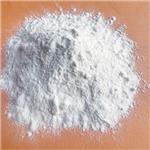Oxamide, H2NCOCONH2, mol wt 80.07, is sparingly soluble in water and insoluble in various organic solvents. It melts at about 350 °C, with accompanying decomposition. Because of the low solubility in water, the compound is granulated and used as a slow-release nitrogen fertilizer.
white fine crystalline powder
Oxamide is used as a stabilizer for nitrocellulose preparations. It also finds use in APCP rocket motors as a high performance burn rate suppressant.
ChEBI: A dicarboxylic acid diamide of oxalic acid.
Oxamide can be prepared, for example, by pyrolyzing ammonium oxalate or by allowing hydrogen cyanide to react with hydrogen peroxide. It is also known to prepare oxamide by a reaction between dimethyl oxalate and ammonia, wherein methanol is produced in addition to oxamide. The preparation was carried out as a batch process in a liquid phase, with methanol acting as a solvent into which the dimethyl oxalate and ammonia are fed. The oxamide was separated from the solution by crystallization, and the remaining mother liquor was distilled to recover methanol and ammonia, which had been left over from the reaction.
Oxamide (H2 NCOCONH2 ), a diamide of oxalic acid, is a
white crystalline and non-hygroscopic fertilizer
containing about 32% nitrogen, most of which is waterinsoluble
at 25°C. Oxamide is made from cyanogen
hydrolysis in an acid medium. It releases nitrogen slowly
and hence is used as a slow-release fertilizer. It is
decomposed by soil micro-organisms in the soil.
Poison by ingestion and intraperitoneal routes. An eye irritant. When heated to decomposition it emits toxic fumes of NOx. See also AMIDES.
Crystallise oxamide from water, grind it and dry it in an oven at 150o. [Beilstein 2 IV 1860.]



